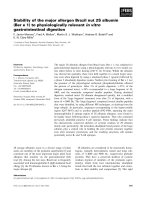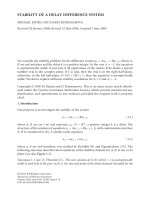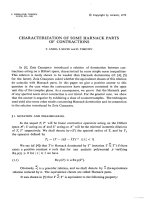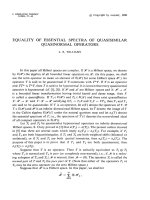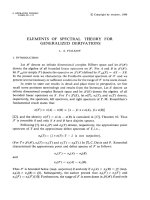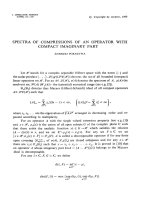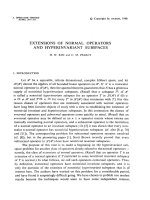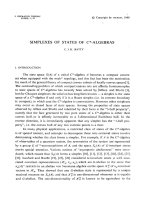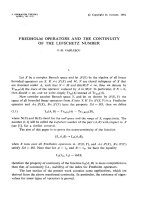Báo cáo toán học: "Stability of Associated Primes of Monomial Ideals" doc
Bạn đang xem bản rút gọn của tài liệu. Xem và tải ngay bản đầy đủ của tài liệu tại đây (178.19 KB, 15 trang )
Vietnam Journal of Mathematics 34:4 (2006) 473–487
Stability of Associated Primes
of Monomial Ideals
*
LˆeTuˆan Hoa
Institute of Mathematics, 18 Hoang Quoc Viet Road, 10307 Hanoi, Vietnam
Dedicated to Professor Do Long Van on the occasion of his 65
th
birthday
Received August 28, 2006
Revised October 4, 2006
Abstract. Let
I b e a monomial ideal of a polynomial ring R.Inthispaperwe
determine a number
B suc h that Ass (I
n
/I
n+1
)=Ass (I
B
/I
B+1
) for all n ≥ B.
2000 Mathematics Subject Classification: 13A15, 13D45
Keywords: Associated prime, monomial ideal.
1. Introduction
Let I be an ideal of a Noetherian ring R. It is a well-known result of Brodmann
[1] that the sequences {Ass (R/I
n
)}
n≥1
and {Ass (I
n
/I
n+1
)}
n≥1
stabilize for
large n. That is, there are positive numbers A and B such that Ass (R/I
n
)=
Ass (R/I
A
) for all n ≥ A and Ass (I
n
/I
n+1
)=Ass(I
B
/I
B+1
) for all n ≥ B.
Very little is known about the numbers A and B. One of the difficulties in
estimating these numbers is that neither of the above sequences is monotonic;
see [6] and also [5] for monomial ideals. In an earlier paper of McAdam and
Eakin [6] and a recent paper of Sharp [9] there are some information about the
behavior of these sequences. Moreover, for specific prime ideals p one can decide
in terms of the Castelnuovo–Mumford regularity of the associated graded ring
of I when p belongs to Ass (R/I
n
) (see [9, Theorem 2.10]). For a very restricted
∗
This work was supported in part by the National Basic Research Program, Vietnam.
474 LˆeTuˆan Hoa
class of ideals the numbers A and B can be rather small (see [7]).
The aim of this paper is to find an explicit value for A and B for a monomial
ideal I in a polynomial ring R = K[t
1
, , t
r
] over a field. A special case was
studied in [2], when I is generated by products of two different variables. Such
an ideal is associated to a graph. The result looks nice: the number A can be
taken as the number of variables (see [2, Proposition 4.2, Lemma 3.1, Corollary
2.2]). However the approach of [2] cannot be applied for arbitrary monomial
ideals.
It is interesting to note that in our situation we can take A = B,since
Ass (R/I
n
)=Ass(I
n−1
/I
n
) (see [12, Proposition 5]). In this paper, it is more
convenient for us to work with Ass (I
n
/I
n+1
) (and hence with the number B).
Let m =(t
1
, , t
r
). Then one can reduce the problem of finding B to finding a
number B
such that m ∈ Ass (I
n
/I
n+1
) for all n ≥ B
or m ∈ Ass (I
n
/I
n+1
)
for all n ≥ B
(see Lemma 3.1). From this observation we have to study the
vanishing (or non-vanishing) of the local cohomology module H
0
m
(I
n
/I
n+1
). The
main technique to do that is to describe these sets as graded components of
certain modules over toric rings raised from systems of linear constraints. Then
we have to bound the degrees of generators of these modules, and also to bound
certain invariants related to the Catelnuovo-Mumford regularity. The number
B found in Theorem 3.1 depends on the number of variables r,thenumberof
generators s and the maximal degree d of generators of I. This number is very
big. However there are examples showing that such a number B should also
involve d and r (see Examples 3.1 and 3.2).
The paper is divided into two sections. The first one is of preparatory char-
acter. There we will give a bound for the degrees of generators of a module
raised from integer solutions of a system of linear constraints. Section 3 is de-
voted to determining the number B. First we will find a number from which the
sequence {Ass (I
n
/I
n+1
)}
n≥1
is decreasing (see Proposition 3.2). Then we will
have to bound a number related to the Castelnuovo-Mumford regularity of the
associated graded ring of I (Proposition 3.3) in order to use a result of [6] on the
increasing property of this sequence. The main result of the paper is Theorem
3.1. This section will be ended with two examples which show how big B should
be.
I would like to end this introduction with the remark that by a different
method, Trung [12] is able to solve similar problems for the integral closures of
powers of a monomial ideal.
2. Integer Solut ions of Linear Constraints
Let S be the set of integer solutions of the following system of linear constraints
a
i1
x
1
+ ···+ a
ie
x
e
≥ 0,i=1, , s,
x
1
≥ 0, , x
e
≥ 0,
(1)
where a
ij
∈ Z. It is a fundamental fact in integer programming that the semi-
group ring K[S] is a finitely generated subring of K[x
1
, , x
e
]. An algebraic
proof can be found in [10, Sec. 1.3]. What we need is an “effective” version of
Stability of Associated Primes of Monomial Ideals 475
this result. To this end we will consider an element of S as a point in the space
R
e
. For a vector v =(v
1
, , v
e
) ∈ R
e
, put
v =
v
2
1
+ ···+ v
2
e
and v
∗
=max{| v
1
|, , |v
e
|}.
The proof of the following lemma and Lemma 2.2 is similar to that of
[8, Theorem 17.1]. For convenience of the readers we give here the detail.
Lemma 2.1. Let a
j
=(a
1j
, , a
sj
)
T
∈ Z
s
denote the coefficient column of x
i
in
(1). Assume that a
1
≥···≥a
e
> 0.ThenK[S] is generated by monomials
x
v
:= x
v
1
1
···x
v
e
e
such that
v
∗
<ea
1
···a
e−1
≤ea
1
···a
e
.
Proof. Let C be the set of all real solutions of (1). It is a polyhedral convex set
in R
e
. By Minkovski’s Theorem (see [8, Corollary 7.1a]), one can write
C = R
+
u
1
+ ···+ R
+
u
k
,
where u
1
, , u
k
∈Cand R
+
is the set of nonnegative numbers. Here we choose k
the smallest possible. Then R
+
u
1
, , R
+
u
k
are extreme rays. Each extreme ray
is an intersection of e −1 independent hyperplanes appeared in (1). Hence, we
may without loss of generality assume that u
p
, 1 ≤ p ≤ k, is a nonzero solution
of a linear subsystem of the type
b
i1
x
1
+ ···+ b
iq
x
q
= −b
i,q+1
x
q+1
,i=1, , q,
x
q+2
= ···= x
e
=0,
(2)
where q ≤ min{e −1,s}, the matrix on the left-hand side is invertible, and each
column vector b
j
is a subvector of a
j
. By Cramer’s rule we may choose u
p
the
integer solution:
u
p
=(D
1
, , D
q
,D
q+1
, 0, , 0),
where D
1
, , D
q+1
are determinants of the linear system consisting of the first
q equations of (2). Note that if c
1
, , c
q
∈ R
q
are column vectors, then
Det (c
1
, , c
q
) ≤c
1
···c
q
. (3)
Hence
u
p
∗
≤ max
i
b
1
···b
i−1
b
i+1
···b
q+1
≤a
1
···a
q
≤a
1
···a
e−1
.
From now on we assume that all elements u
1
, , u
k
are integer points chosen
in the above way. In particular they belong to S.Letv ∈ S be an arbitrary
element. Since v ∈C, by Caratheodory’s theorem (see [8, Corollary 7.1i)]), one
can find {i
1
, , i
q
}⊆{1, , k},q≤ e and numbers α
i
1
, , α
i
q
≥ 0, such that
v = α
i
1
u
i
1
+ ···+ α
i
q
u
i
q
.
For a real number α,let[α] denote the largest integer not exceeding α.Let
u =[α
i
1
]u
i
1
+ ···+[α
i
q
]u
i
q
,
476 LˆeTuˆan Hoa
and
w =(α
i
1
−[α
i
1
])u
i
1
+ ···+(α
i
q
−[α
i
q
])u
i
q
.
We have w = v − u ∈ N
e
. However w ∈C. Hence w ∈C∩N
e
= S. Since
v = u + w, this means that the following set generates S:
{u
1
, , u
k
}∪{α
i
1
u
i
1
+ ···+ α
i
q
u
i
q
∈ N
e
| q ≤ e, 0 ≤ α
i
j
< 1, 1 ≤ i
1
, , i
q
≤ k}.
For each vector v = α
i
1
u
i
1
+···+α
i
q
u
i
q
in the second subset of the above union
we have
v
∗
<q max
j=1, ,k
u
j
∗
≤ e max
j=1, ,k
u
j
∗
≤ ea
1
···a
e−1
.
Hence the assertion holds true.
The following simple example shows that the above result is essentially op-
timal.
Example 2.1. Consider the system of constraints
⎧
⎪
⎪
⎪
⎨
⎪
⎪
⎪
⎩
dx
1
−x
2
≥ 0,
···
dx
e−1
− x
e
≥ 0,
x
1
≥ 0, , x
e
≥ 0.
The corresponding polyhedral convex set has an extreme ray R
+
u,whereu =
(1, d, , d
e−1
). Clearly, u is a minimal generator of S.
We now consider the set E of integer solutions of the following system of
linear constraints:
a
i1
x
1
+ ···+ a
ie
x
e
≥ b
i
, (i =1, , s),
x
1
≥ 0, , x
e
≥ 0,
(4)
where a
ij
,b
i
∈ Z.SinceS + E ⊆ E, K[E] is a module over K[S]. For simplicity,
sometimes we also say that E is a S-module.
Lemma 2.2. Keep the notation of Lemma 2.1. Let b =(b
1
, , b
s
)
T
∈ Z
s
.Then
the module K[E] is generated over K[S] by monomials x
v
such that
v
∗
< (e + b)a
1
···a
e
.
Proof. Let C
be the set of all real solutions of (4). Then C
is also a polyhedral
convex set. By Minkovski’s theorem one can write
C
= {λ
1
u
1
+ ···+ λ
k
u
k
+ μ
1
v
1
+ ···+ μ
l
v
l
| λ
i
,μ
j
≥ 0,
μ
j
=1},
where u
1
, , u
k
are defined in the proof of the previous lemma, and v
1
, , v
l
are extreme points. These extreme points are solutions of e independent affine
Stability of Associated Primes of Monomial Ideals 477
hyperplanes appeared in (4). By a similar argument to the proof of Lemma 2.1
we get that
v
j
∗
≤b·a
1
···a
e−1
,
and that the set
{λ
i
1
u
i
1
+ ···+ λ
i
q
u
i
q
+ μ
1
v
1
+ ···+ μ
l
v
l
∈ N
e
|q ≤ e, 1 ≤ i
1
< ···<i
q
≤ k,
0 ≤ λ
i
j
< 1,μ
j
≥ 0,
μ
j
=1}
generates the module E over S. All these elements have the ∗-norms less than
e max
i
u
i
∗
+max
j
v
j
∗
≤ (e + b)a
1
···a
e
,
which proves the assertion.
Remark 2.1. In the sequel, by abuse of terminology, if
ϕ(x)=a
1
x
1
+ ···+ a
e
x
e
,
is a linear functional, then we say that ϕ(x) ≥ 0 is a homogeneous linear con-
straint, while ϕ(x) ≥ b is a linear constraint.
3. Stability of Ass (I
n
/I
n+1
)
We always assume that I is a non-zero monomial ideal of a polynomial ring R =
K[t
1
, , t
r
]. If r ≥ 2, then for a positive integer j ≤ r and a =(a
1
, , a
r
) ∈ R
r
we set
a[j]=(a
1
, , a
j−1
,a
j+1
, , a
r
).
Thus the monomial t
a[j]
is obtained from t
a
by setting t
j
=1. LetI[j]bethe
ideal generated by all monomials t
a[j]
such that t
a
∈ I.Notethatt
a
1
[j]
, , t
a
s
[j]
generate I[j]provided{t
a
1
, , t
a
s
} is a generating system of I. Hence for all n
we have
I
n
[j]=I[j]
n
.
The following observation is simple but useful. It comes from the fact that any
associated prime of a monomial ideal is generated by a subset of variables.
Lemma 3.1. Let m =(t
1
, , t
r
) and r ≥ 2. Then for all n ≥ 1 we have
Ass (I
n
/I
n+1
) \{m} = ∪
r
i=1
Ass (I[i]
n
/I[i]
n+1
).
Proof. It immediately follows from [12, Lemma 11 and Proposition 4]. Another
way is to modify the proof of Lemma 11 in [12].
Using this lemma, by the induction on the number of variables, it is clear
that in order to study the stability of Ass (I
n
/I
n+1
) we have to find a number
n
0
such that m ∈ Ass (I
n
/I
n+1
) for all n ≥ n
0
, or vice-versa, m ∈ Ass (I
n
/I
n+1
)
478 LˆeTuˆan Hoa
for all n ≥ n
0
.Notethatm ∈ Ass (I
n
/I
n+1
) if and only if the local cohomology
module H
0
m
(I
n
/I
n+1
) =0. Let
G = ⊕
n≥0
I
n
/I
n+1
denote the associated graded ring of I.ThenH
0
mG
(G) is a graded G-module.
Moreover, as a submodule of G, it is a finitely generated module. We have
Lemma 3.2. For r ≥ 2, H
0
mG
(G)
n−1
∼
=
H
0
m
(I
n−1
/I
n
)
∼
=
I
n−1
∩I[1]
n
∩···∩I[r]
n
I
n
.
Proof. The first isomorphism is well-known (see, e.g., [3, Lemma 2.1] for a proof),
while the second one follows from the fact
I
n
:(x
1
, , x
r
)
∞
= ∩
r
i=1
(I
n
: x
∞
i
)=∩
r
i=1
I[i]
n
.
Here we denote I : J
∞
= ∪
∞
m=1
I : J
m
.
The first isomorphism of the above lemma allows us to study H
0
m
(I
n
/I
n+1
),
n ≥ 0, in the total. Our preliminary task is to bound the degree of generators
of the module H
0
mG
(G). Let
J = I[1]
n
∩···∩I[r]
n
.
We will try to associate the set of monomials in J ∩ I
n−1
to the set of integer
solutions of a system of linear constraints, so that we can use the results of Sec. 2.
Our technique is based on the following remarks which will be used several times.
Note that this technique was used in Sec. 7 of [4].
Remark 3.1.
(i) An intersection of monomial ideals and a quotient of two monomial ideals
are again monomial ideals.
(ii) A monomial ideal is entirely defined by the set of its monomials. If I
1
⊂ I
2
are monomial ideals, then the number of monomials in I
2
\ I
1
is equal to
the dimension of the K-vector space I
2
/I
1
.
(iii) Assume that the monomials t
a
1
, , t
a
s
generate the ideal I. Then a mono-
mial t
b
∈ I
n
if and only if there are nonnegative integers α
1
, , α
s−1
,such
that n ≥ α
1
+ ···+ α
s−1
and t
b
is divisible by
(t
a
1
)
α
1
···(t
a
s−1
)
α
s−1
(t
a
s
)
n−α
1
−···−α
s−1
.
This is equivalent to
b
j
≥ a
1j
α
1
+ ···+ a
(s−1)j
α
s−1
+ a
sj
(n − α
1
−···−α
s−1
),
for all j =1, , r,wherea
i
=(a
i1
, , a
ir
).
From now on assume that I is minimally generated by the monomials t
a
1
, , t
a
s
.
Note that if I is generated by powers of variables, i. e. I =(t
a
1
i
1
, , t
a
p
i
p
), then
Ass (I
n
/I
n+1
)={(t
i
1
, , t
i
p
)}
Stability of Associated Primes of Monomial Ideals 479
for all n>0. Therefore, in the whole paper we may assume that
() a
s
contains at least two non-zero components.
This will simplify our calculation.
Consider the following system of linear constraints
⎧
⎪
⎪
⎪
⎪
⎪
⎪
⎪
⎪
⎨
⎪
⎪
⎪
⎪
⎪
⎪
⎪
⎪
⎩
y
j
≥ a
1j
x
1
+ ···+ a
(s−1)j
x
s−1
+ a
sj
(z − x
1
−···−x
s−1
− 1), (j =1, , r),
z ≥ x
1
+ ···+ x
s−1
+1,
y
j
≥ a
1j
x
i1
+ ···+ a
(s−1)j
x
i(s−1)
+ a
sj
(z − x
i1
−···−x
i(s−1)
),
(i, j =1, , r; j = i),
z ≥ x
i1
+ ···+ x
i(s−1)
, (i =1, , r),
z ≥ 0; y
1
≥ 0, , y
r
≥ 0; x
1
≥ 0, , x
s−1
≥ 0; x
11
≥ 0, , x
r(s−1)
≥ 0.
(5)
For short, we set
u =(u
0
, , u
rs+s−1
)=(z, y
1
, , y
r
,x
1
, , x
s−1
,x
11
, , x
r(s−1)
).
By Remark 3.1, a monomial t
b
∈ J ∩ I
n−1
if and only if the system (5) has an
integer solution u
∗
such that u
∗
0
= n, u
∗
1
= b
1
, , u
∗
r
= b
r
.
The corresponding system of homogeneous linear constraints is
⎧
⎪
⎪
⎪
⎪
⎪
⎪
⎪
⎪
⎨
⎪
⎪
⎪
⎪
⎪
⎪
⎪
⎪
⎩
y
j
≥ a
1j
x
1
+ ···+ a
(s−1)j
x
s−1
+ a
sj
(z − x
1
−···−x
s−1
), (j =1, , r),
z ≥ x
1
+ ···+ x
s
,
y
j
≥ a
1j
x
i1
+ ···+ a
(s−1)j
x
i(s−1)
+ a
sj
(z − x
i1
−···−x
i(s−1)
),
(i, j =1, , r; j = i),
z ≥ x
i1
+ ···+ x
i(s−1)
, (i =1, , r),
z ≥ 0; y
1
≥ 0, , y
r
≥ 0; x
1
≥ 0, , x
s−1
≥ 0; x
11
≥ 0, , x
r(s−1)
≥ 0.
(6)
An integer solution (n, b, x) of this system gives a monomial t
b
∈ J ∩ I
n
= I
n
.
Denote the sets of all integer solutions of (5) and (6) by E and S, respectively.
Then K[S],K[E] ⊆ K[u]andK[E]isaK[S]-module. Equip K[S]andK[E]
with an N-grading by setting
deg (u
c
)=c
0
.
Let I be the ideal of K[S] generated by all binomials u
α
− u
β
, such that α
0
=
β
0
, , α
r
= β
r
.
Lemma 3.3. There is an isomorphism of N-graded rings
K[S]/I
∼
=
R := ⊕
n≥0
I
n
t
n
.
Proof. The above discussion shows that there is an epimorphism of N-graded
rings:
K[S] →R,
u
c
→ t
c
1
1
···t
c
r
r
t
c
0
.
480 LˆeTuˆan Hoa
The kernel of this map is exactly I. The proof is similar to that of Lemma 4.1
in [11], or we can argue directly as follows. By Lemma 2.1, K[S] is generated
by a finite number of monomials, say u
c
1
, , u
c
p
. Consider the polynomial ring
K[v]ofp new variables v =(v
1
, , v
p
). By [11], Lemma 4.1, the kernel of the
epimorphism
ψ : K[v] → K[S],ψ(v
i
)=u
c
i
,
is the ideal I
A
generated by binomials v
α
−v
β
such that
p
i=1
α
i
c
i
=
p
i=1
β
i
c
i
.
Such an ideal is called toric ideal associated to the matrix A := {c
1
, , c
p
}.Let
c
i
=(c
i0
, , c
ir
)andA
:= {c
1
, , c
p
}. Again by [11], Lemma 4.1, the kernel of
the epimorphism
χ : K[v] →R, v
i
→ t
c
i1
1
···t
c
ir
r
t
c
i0
,
is I
A
. Clearly I
A
⊆ I
A
, ψ(I
A
)=I. Hence χ induces an isomorphism
ϕ : K[S] →R,
such that Ker ϕ = I and ϕ(u
c
i
)=χ(v
i
). This implies
ϕ(u
c
)=t
c
1
1
···t
c
r
r
t
c
0
for all c ∈ S.
By this isomorphism, we can consider the quotient module K[E]/IK[E]as
a module over R.Ofcourse,H
0
mG
(G) can be considered as a module over R,
too.
Lemma 3.4. Let r ≥ 2. Then there is an epimorphism of N-graded modules
over R
K[E]/IK[E] →⊕
n≥1
J ∩I
n−1
I
n
t
n
= H
0
mG
(G).
Proof. The set M = ⊕
n≥1
(J ∩I
n−1
)t
n
is a module over R and contains the ideal
IR. The isomorphism ϕ in the proof of Lemma 3.3 induces a homomorphism
K[E]/IK[E] → M,
u
c
→ t
c
1
1
···t
c
r
r
t
c
0
,
which is clearly surjective. Since H
0
mG
(G)
∼
=
M/IR, it is an image of K[E]/IK[E].
Proposition 3.1. Let r ≥ 2 and d be the maximal degree of the generators of
I, i.e. d =max
i
(a
i1
+ ···+ a
ir
). Then the R-module H
0
mG
(G) is generated by
homogeneous elements of degrees less than
B
1
:= d(rs + s + d)(
√
r)
r+1
(
√
2d)
(r+1)(s−1)
.
Proof. By Lemma 3.4, it suffices to show that K[E] is generated over K[S]by
monomials of degrees less than B
1
. The system (5) has rs + s variables. Denote
Stability of Associated Primes of Monomial Ideals 481
by δ(x) the vector obtained from the coefficient vector of a variable x by dele-
ting already known zero entries. For simplicity we write it in the row form. Then
δ(x
ik
)=(a
k1
−a
s1
, , a
k(i−1)
−a
s(i−1)
,a
k(i+1)
− a
s(i+1)
, , a
kr
− a
sr
, −1).
We have
δ(x
ik
)
2
≤ 1+(a
k1
− a
s1
)
2
+ ···+(a
kr
−a
sr
)
2
≤ 1+(a
2
k1
+ ···+ a
2
kr
)+(a
2
s1
+ ···+ a
2
sr
)
≤ 1+(a
k1
+ ···+ a
kr
)
2
+(a
s1
+ ···+ a
sr
)
2
−2
i<j
a
si
a
sj
< 2d
2
(by the condition ()).
Similarly,
δ(x
i
)
2
< 2d
2
.
For all j =1, , r, δ(y
j
)=(1, , 1) (r entries 1). Hence
δ(y
j
)
2
= r.
Further,
δ(z)=(a
s
, a
s
[1], , a
s
[r], 1, , 1) (r +1entries1).
This yields
δ(z)
2
= r(a
2
s1
+ ···+ a
2
sr
)+r +1<rd
2
.
For the free coefficients of (5) we have δ =(a
s1
, , a
sr
, 1). So
δ
2
<d
2
.
Applying Lemma 2.2 we get that K[E] is generated over K[S] by monomials u
c
with
c
∗
< (rs + s + d)
√
rd(
√
2d)
(r+1)(s−1)
√
r
r
= B
1
.
Since deg (u
c
)=c
0
≤c
∗
<B
1
, the proof of the proposition is complete.
Proposition 3.2. Keep the notation of Proposition 3.1.Letn ≥ B
1
be an
integer. Then
Ass (I
n
/I
n+1
) ⊇ Ass (I
n+1
/I
n+2
).
Proof. Induction on the number of variables r.Thecaser = 1 is trivial. Let
r ≥ 2. By the induction hypothesis we have
∪
r
i=1
Ass (I[i]
n
/I[i]
n+1
) ⊇∪
r
i=1
Ass (I[i]
n+1
/I[i]
n+2
).
If m ∈ Ass (I
n
/I
n+1
), then the above inclusion together with Lemma 3.1 obvi-
ously give the assertion. Let m ∈ Ass (I
n
/I
n+1
). Then H
0
mG
(G)
n
= H
0
m
(I
n
/I
n+1
)
= 0. Since the module H
0
mG
(G) is generated by elements of degrees less than B
1
over the standard graded ring R and n ≥ B
1
,wemusthaveH
0
mG
(G)
n+1
=0.
482 LˆeTuˆan Hoa
This implies m ∈ Ass (I
n+1
/I
n+2
). Hence, we have by Lemma 3.1
Ass (
I
n+1
I
n+2
)=Ass(
I
n+1
I
n+2
) \{m}
= ∪
r
i=1
Ass (
I[i]
n+1
I[i]
n+2
) ⊆∪
r
i=1
Ass (
I[i]
n
I[i]
n+1
) ⊆ Ass (
I
n
I
n+1
).
In order to get the reverse inclusion we use a result of McAdam and Eakin
(see [6, pp. 71, 72] and also [9, Proposition 2.4]). Let
R
+
= ⊕
n>0
I
n
t
n
.
The local cohomology module H
0
R
+
(G)isalsoaZ-graded R-module. Let
a
0
(G)=sup{n| H
0
R
+
(G)
n
=0}.
(This number is to be taken as −∞ if H
0
R
+
(G) = 0.) It is related to an important
invariant called the Castelnuovo-Mumford regularity of G (see, e.g., [9]). We
have
Lemma 3.5. ([6, Proposition 2.4]) Ass (I
n
/I
n+1
) ⊆ Ass (I
n+1
/I
n+2
) for all
n>a
0
(G).
To define H
0
R
+
(G), let us recall the Ratliff–Rush closure of an ideal:
I
n
= ∪
m≥1
I
n+m
: I
m
.
This immediately gives
Lemma 3.6. For al l n>0 we have H
0
R
+
(G)
n−1
∼
=
(
I
n
∩ I
n−1
)/I
n
.
Recall that I =(t
a
1
, , t
a
s
).
Lemma 3.7. For al l n>0 we have
I
n
= ∪
m≥0
I
n+m
:(t
ma
1
, , t
ma
s
).
Proof. Since t
ma
i
∈ I
m
, the inclusion ⊆ is obvious. To show the inclusion ⊇,let
x ∈ I
n+m
:(t
ma
1
, , t
ma
s
).
Put m
= sm and let y be an arbitrary element in I
m
.Theny =(t
ma
i
)y
for
some i and y
∈ I
m
−m
.Wehave
xy = y
(xt
ma
i
) ∈ y
I
n+m
⊆ I
n+m
.
This implies
x ∈ I
n+m
: I
m
⊆
I
n
.
Stability of Associated Primes of Monomial Ideals 483
Proposition 3.3. We have
a
0
(G) <B
2
:= s(s + r)
4
s
r+2
d
2
(2d
2
)
s
2
−s+1
.
Proof. Consider the following system of linear constraints
⎧
⎪
⎪
⎪
⎨
⎪
⎪
⎪
⎩
y
j
+ a
ij
x ≥ a
1j
x
i1
+ ···+ a
(s−1)j
x
i(s−1)
+ a
sj
(z + x − x
i1
−···−x
i(s−1)
),
z + x ≥ x
i1
+ ···+ x
i(s−1)
,
(i =1, , s; j =1, , r),
z ≥ 0,x≥ 0; y
1
≥ 0, , y
r
≥ 0; x
11
≥ 0, , x
s(s−1)
≥ 0.
(7)
By Lemma 3.7 and Remark 3.1 we have t
b
∈
I
n
if and only if there is an integer
solution
u := (u
0
, , u
s(s−1)+r+1
):=(z, x,y
1
, , y
r
,x
11
, , x
s(s−1)
)
of (7) such that z = n and b =(u
2
, , u
r+1
). This system has s(s − 1) + r +2
variables. Using the notation in the proof of Proposition 3.1, a straightforward
calculation gives
δ(x
ij
)
2
< 2d
2
, δ(y
k
)
2
= s, δ(z)
2
<sd
2
, δ(x)
2
< 2sd
2
.
Let S be the set of all integer solutions of (7). By Lemma 2.1, the ring K[S]is
generated by monomials, say u
c
1
, , u
c
p
,with
c
j
∗
< (s(s − 1) + r +2)(
√
2d)
s(s−1)
√
sd
√
2sd
√
s
r
< [(s + r)
2
d(
√
2d)
s
2
−s+1
√
s
r+2
] − 1=:B
3
.
Fix such a generator u
c
j
of K[S]. Let
c
j
=(c
j2
, , c
j(r+1)
).
Then from (7) we have
(t
a
i
)
c
j1
t
c
j
∈ I
c
j0
+c
j1
.
Since c
j1
<B
3
, this implies that
(t
a
i
)
B
3
t
c
j
∈ I
c
j0
+B
3
,
for all i ≤ s.Let
B
4
= sB
3
.
Since
I
sB
3
=
s
i=1
(t
a
i
)
B
3
I
(s−1)B
3
,
from the above relationship we get
I
B
4
t
c
j
⊆ I
c
j0
+B
4
. (8)
We will show that
I
n
= I
n
for all n ≥ B
4
(B
3
+1). Forthis aim,let t
b
∈
I
n
484 LˆeTuˆan Hoa
with
n ≥ B
4
(B
3
+1).
Then there are α ∈ N and α
=(α
11
, , α
s(s−1)
), such that (n, α, b,α) ∈ S.Since
c
1
, , c
p
generate S, there are nonnegative integers m
1
, , m
p
such that
(n, α, b,α
)=m
1
c
1
+ ···+ m
p
c
p
.
This implies
m
1
c
10
+ ···+ m
p
c
p0
= n,
and
t
b
=(t
c
1
)
m
1
···(t
c
p
)
m
p
.
Repeated application of (8) gives
(t
a
i
)
B
4
t
b
∈ I
n+B
4
,
for all i ≤ s.Inotherwords,
t
b
∈ I
n+B
4
:(t
B
4
a
1
, , t
B
4
a
s
).
Hence there is β
=(β
ij
) ∈ N
s(s−1)
such that (n, B
4
, b,β) ∈ S. Then one can
write
(n, B
4
, b,β)=
c
i1
=0
m
i
c
i
+
c
i1
>0
m
i
c
i
, (9)
for some m
i
,m
i
∈ N.Wehave
n =
c
i1
=0
m
i
c
i0
+
c
i1
>0
m
i
c
i0
.
Comparing the second components in (9) gives
m
i
≤
m
i
c
i1
= B
4
.
Since c
i0
≤c
i
∗
≤ B
3
,wemusthave
m
i
c
i0
= n −
c
i1
>0
m
i
c
i0
≥ n − B
3
m
i
≥ B
4
(B
3
+1)−B
3
B
4
= B
4
.
In particular, the set of c
i
with c
i1
= 0 in (9) is not empty. From (7) one can
see that for such an index i we have t
c
i
∈ I
c
i0
. Therefore, by (9) one obtains
t
b
= t
b
t
b
,
where
t
b
∈ I
m
i
c
i0
⊆ I
B
4
,
and
t
b
=
c
i1
>0
(t
c
i
)
m
i
.
Repeated application of (8) once more gives us t
b
∈ I
n
.Thuswehaveshown
Stability of Associated Primes of Monomial Ideals 485
I
n
= I
n
.
Since
B
4
(B
3
+1)=sB
3
(B
3
+1)<s[(s + r)
2
d(
√
2d)
s
2
−s+1
√
s
r+2
]
2
≤ B
2
,
from Lemma 3.6 we get a
0
(G) <B
2
.
Finally we can prove
Theorem 3.1. Let
B =max{d(rs + s + d)(
√
r)
r+1
(
√
2d)
(r+1)(s−1)
,s(s + r)
4
s
r+2
d
2
(2d
2
)
s
2
−s+1
}.
Then we have
Ass (I
n
/I
n+1
)=Ass (I
B
/I
B+1
)
for all n ≥ B.
Proof. Note that B =max{B
1
,B
2
}. By Proposition 3.2, Ass (I
n
/I
n+1
) ⊆
Ass (I
B
/I
B+1
). By Lemma 3.5 and Proposition 3.3, Ass (I
n
/I
n+1
) ⊇ Ass
(I
B
/I
B+1
).
The number B in the above theorem is very big. However the following
examples show that such a number B should depend on d and r.
Example 3.1. Let d ≥ 4and
I =(x
d
,x
d−1
y, xy
d−1
,y
d
,x
2
y
d−2
z) ⊂ K[x, y, z].
A monomial ideal of this type was used in the proof of Theorem 4.1 in [5]. We
have
I
n
:(x, y, z)
∞
=(x
d
,x
d−1
y, xy
d−1
,y
d
,x
2
y
d−2
)
n
= I
n
if and only if n ≥ k − 2. Hence
Ass (I
n−1
/I
n
)=
{(x, y, z), (x, y)} if n<d− 2,
{(x, y)} if n ≥ d − 2.
Example 3.2. Let r ≥ 4andd>r−3. We put
u = t
(
r−3
0
)
1
t
(
r−3
1
)
2
···t
(
r−4
0
)
r−3
and v = t
β
1
1
···t
β
r−4
r−3
t
d−r+2
r−2
,
where
β
i
=
0ifr −3 −i is even,
2
r−3
i
if r − 3 − i is odd.
Let
I =(ut
d
1
,ut
d−1
2
t
r
, , ut
d−r+3
r−2
t
r−3
r
,ut
r−1
t
d−1
r
,vt
r−3
r
),
and J be the integral closure
I
r
of I
r
. Assume that
Ass (J
n−1
/J
n
)=Ass(J
B−1
/I
B
)
486 LˆeTuˆan Hoa
for all n ≥ B.Then
B ≥
d(d − 1) ···(d − r +3)
r(r −3)
.
Note that in this example J is generated by monomials of degree r(d +2
r−3
−1).
Thus, if r is fixed, then B is at least O(d(J)
r−2
), where d(J) is the maximal
degree of the generators of J.
Proof. By [13, Corollary 7.60], J is a normal ideal. Using the filtration
J
n
= I
rn
⊂ I
rn−1
⊂···⊂I
r(n−1)
= J
n−1
,
we get
Ass (
I
rn−1
/I
rn
) ⊆ Ass (J
n−1
/J
n
) ⊆∪
r
i=1
Ass (I
r(n−1)+i−1
/I
r(n−1)+i
).
By virtue of [12, Proposition 4], it is shown in the proof of [12, Proposition 16],
that
m ∈ Ass (
I
k−1
/I
k
) for all k 0,
and
m ∈ Ass (
I
k−1
/I
k
)ifk<δ:=
d(d − 1) ···(d − r +3)
(r −3)
.
Hence m ∈ Ass (J
n−1
/J
n
) for all n 0. Assume that
B<
d(d − 1) ···(d − r +3)
r(r −3)
= δ/r.
Then Br < δ, and hence m ∈ Ass (
I
r(B−1)+i−1
/I
r(B−1)+i
) for all i ≤ r.This
implies m ∈ Ass (J
B−1
/J
B
), a contradiction.
References
1. M. Brodmann, Asymptotic stability of Ass (M/I
n
M), Proc. Amer. Math. Soc.
74 (1979) 16–18.
2. J. Chen, S. Morey, and A. Sung, The stable set of associated primes of the ideal
of a graph, Rocky Mountain J. Math. 32 (2002) 71–89.
3. D. Cutk osky, J. Herzog, and N. V. Trung, Asymptotic behavior of the Castelnuovo–
Mumford regularity, Compositio Math. 118 (1999) 243–261.
4. J. B. Fields, Lengths of Tors determined by killing powers of ideals in a local ring,
J. Algebra 247 (2002) 104–133.
5. J. Herzog and T. Hibi, The depth of powers of an ideal, J. Algebra 291 (2005)
534–550.
6. S. McAdam and P. Eakin, The asymptotic Ass , J. Algebra 61 (1979) 71–81.
7. S. Morey, Stability of associated primes and equality of ordinary and symbolic
powers of ideals, Comm. Algebra 27 (1999) 3221–3231.
8. A. Schrijver, Theory of Linear and Integer Programming, John Wiley
& Sons,
Ltd., Chichester, 1986.
Stability of Associated Primes of Monomial Ideals 487
9. R. Y. Sharp, Convergence of sequences of sets of associated primes, Proc. Amer.
Math. Soc. 131 (2003) 3009–3017.
10. R. P. Stanley, Combinatorics and comm utative algebra, 2
nd
Edition, Progress in
Mathematics, 41. Birkh¨auser Boston, Inc., Boston, MA, 1996.
11. B. Sturmfels, Gr¨obner bases and convex polytopes, University Lecture Series, 8,
Amer. Math. Soc., Providence, RI, 1996.
12. T.N. Trung, Stability of associated primes of integral closures of monomial ideals,
Preprint Institute of Mathematics Hanoi, 2006.
13. W. Vasconcelos, Integral Closure, Rees Algebras, Multiplicities, Algorithms, Springer
Monographs in Mathematics, Springer-Verlag, Berlin, 2005.
